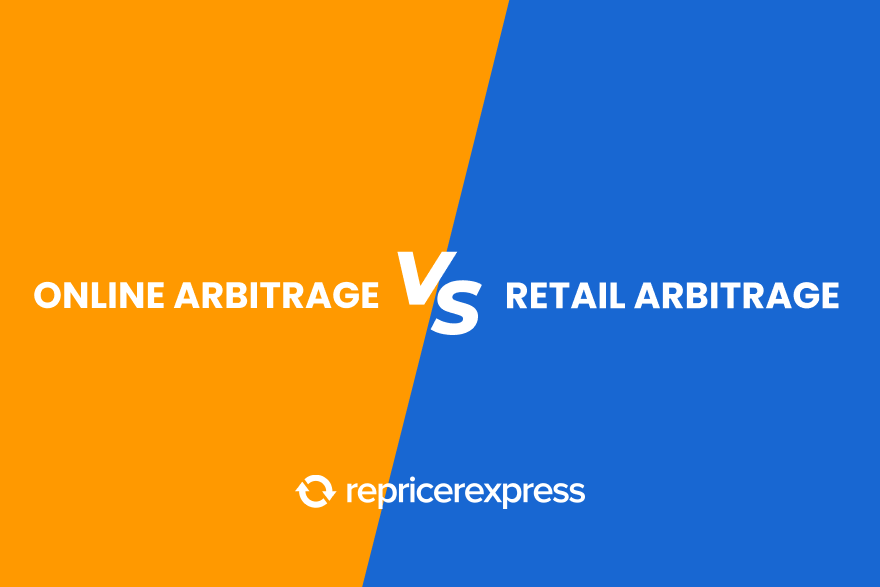Third-party sellers who source products via arbitrage to resell on Amazon usually choose online arbitrage or retail arbitrage, also known as OA or RA.
In this post, we’ll take a look at what each means, share tips for doing arbitrage on Amazon as well as looking at some of the top reasons why some people fail with online arbitrage.
What is Amazon Arbitrage?
First things first, what is arbitrage? In essence, arbitrage is the practice of knowing an item’s price and capitalising on its differences in different markets.
Amazon arbitrage is a type of reselling that is quite common and growing in popularity as the number of Amazon sellers increases.
Sellers will find products either online or in retail stores that are selling for cheaper than they are on Amazon. To identify profitable inventory quickly, shrewd sellers will use a scanning app.
When it comes to arbitrage on Amazon, there are two ways you can go about it: online arbitrage and retail arbitrage.
Online Arbitrage vs Retail Arbitrage: Which is Better?
The neat thing about arbitrage is that you don’t have to stick to one method — you can (as many sellers do) carry out both online and retail at the same time.
Why leave money on the table if you know you can find good opportunities in-store and online?
Out of the two, we probably prefer online arbitrage because it’s easier and something you can do from the comfort of your own home.
Some retailers also offer you the opportunity to order online and then pick up in-store.
Retail Arbitrage on Amazon
Retail arbitrage is the more traditional method of bargain hunting. For retail arbitrage, the source is usually a brick and mortar store such as an outlet store or retail chain.
Sellers are usually going to big retailers and looking for clearance stock, liquidations or reduced stock that they know they can sell on Amazon for a nice profit.
And the more you do it, you quicker you get at finding those hidden gems.
For example, I might pick up ten Spiderman toys in Best Buy for $10 that according to my price tracking app have been selling on Amazon recently for $25. I know that gives me a $15 profit on each item before Amazon seller fees.
If you’re interested in learning more about the process, I highly recommend checking out Stephen Smotherman’s guide to smashing retail arbitrage on Amazon as well as this post by top FBA seller Kev Blackburn where he explores is retail arbitrage on Amazon FBA dead?
Next up, we’re going to look at Amazon online arbitrage.
What is Online Arbitrage on Amazon?
For online arbitrage on Amazon, the source has an online presence usually in the form or a website or Facebook shop.
The downside of retail arbitrage is petrol costs and time spent sourcing. And with increased competition, those awesome deals don’t hang around for long.
But if you source deals online using online arbitrage you don’t need to travel anywhere, you can do it any time of the day or night and you can usually buy in bigger quantities.
You can source from any website where you see reselling opportunities. If you can buy in bulk at low prices and resell quickly for a nice profit then that is the dream.
Plus, you can hook up with as many retailers as you want and buy as much or as little as you want.
Seller Tips for Doing Arbitrage on Amazon
If you’re selling on Amazon then you need to play by their rules so keep an eye on their ever-changing selling policies.
When it comes to arbitrage on Amazon, here are some things you need to remember.
- When sourcing for reselling on Amazon, keep in mind Amazon’s fees so you can factor in a profit for yourself.
- You may be required to provide invoices for items sold as “new” condition on Amazon.
- Trademark owners may ask Amazon to stop sellers from selling items sources through arbitrage.
- Brand owners may insist on arbitrage stock being sold as “like new”.
- Use Chrome browser extensions like Keepa and CamelCamelCamel to keep close tabs on an item’s price and rank history so you can capitalise as sharply as possible. Try and avoid items with abnormal or quick spikes in prices because that’ll usually translate to fewer or thinner profit margins on Amazon.
- Start with arbitrage on Amazon the way you would with lending money: don’t invest anything that you’re not prepared to lose.
- Smell what sells and reinvest your profits into new inventory.
- Look for quick resale opportunities so you avoid storage fees and get a return on your investment quicker.
- Practice the saying of “measure twice, cut once” principle when it comes to research. The more studying you do, the likelier your chances of success will be.
- Consider hiring staff (or family and friends) to help you find and buy items for reselling.
Why People Fail With Amazon Online Arbitrage
RepricerExpress user and expert seller Kev Blackburn (LifeSuccess Engineer) reveals the top ten reasons why sellers fail with online arbitrage.
- False expectations
- Lack of Data/emotional selection
- Chasing sales/revenue and not profit
- One man band mentality
- Systems mindset
- Lack of investment
- Accounting (purchasing)
- Accounting (money management)
- Expanding too rapidly
- Fixed mindset – lack of learning
Check out the video below where Sophie Dearden and Kev Blackburn discuss the top reasons why people fail with online arbitrage on Amazon. Learn from the experts and avoid the mistakes of others.
Final Thoughts
Selling using online or retail arbitrage on Amazon can be a lucrative side hustle. And if you’re selling on Amazon and eBay then you’ll want to save time (and increase profits) by outsourcing your price management to an Amazon repricer.
It’s free to try for 14 days, no credit card needed so what have you got to lose?






